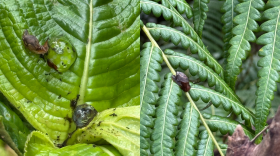Anti-Asian hate has been in the news lately, and race relations have simmered in the news in the U.S. since they blew up last summer. A new exhibit at the Bishop Museum shows how early anthropological research here in Hawai‘i was related to racist beliefs that include Native Hawaiians.
The exhibit involves both subtleties and glaring truths about racism.

Overlapping stories combine with discredited scientific accoutrements in the Bishop Museum's new exhibition, (Re)Generations. Ultimately, viewers are faced with the new realization that race as we think of it, does not exist in science.
"So genetics did a lot to help disprove this idea of race as a construct," says Jillian Swift, archaeology curator at Bishop Museum. Swift worked with Bishop Museum archive director Leah Caldera and geneticist Keolu Fox of the University of California, San Diego, to mount this exhibit.
"There's very, very little genetic variation between people and populations. And the part that varies doesn't map onto what we know as racial categories," Swift says. "These categories are entirely socially constructed."
Swift says scientists today don't talk about race definied by characteristics like facial features, build and skin color. Scientists talk about populations with internal variation and overlapping edges.
"We're humans and we need to understand things, and dealing with chaos is a lot more difficult than dealing with neat little categories," she says. "But if those categories aren't real then that's something we have to reckon with. That is the case for racial categories."
While there is biological reality to race, Swift says, there is a social reality connected to differences in skin color, nose size, eye shape.
"We invented them. They're not biologically real. And that's an important distinction," Swift says. "Once we understand that distinction, we can start to see the social mechanisms that enable race and racism."
Between 1920 and 1925, anthropologist Louis R. Sullivan was in Hawai‘i on a joint project for Bishop Museum and the American Museum of Natural History. Eugenics, the idea that humans could be "improved" thrugh deliberate selection, was popular at the time. Measurements and scientific methods were directed toward defining races scientifically.
"So there was already this attempt to create links that don't exist between physical characteristics and other inherent abilities," Swift says.
As part of his research, Sullivan document characteristics of different populations in Hawaii‘i. Hawaiians especially were sought out, since Bishop Museum was seeking to solve the "problem" of Polynesian origins. Measurements and classifications have been used to justify slavery, displacement, colonial occupation and genocide.
"All of this is now discredited," Swift says. "I have to stress, all of this is building a scientific endavor onto a false premise. The thing about science is that it self corrects over timebut the problem is popular imagination, political imagination, all of these thigns are slower to take that in, and slower to change."
Ultimately, Sullivan collected 952 photographs, and the collection was presented at the Second International Eugenics Conference in New York City in 1921, with Bishop Museum's endorsement and support.
"We wanted to be very honest about the origins of the collection," Swift says. "We didn't want to shy away from that. We didn't want to shy away from our responsibilities in that. We also wanted to make sure that that aspect of the story could be drawn into present day. These issues haven't gone away. They manifest in new ways now."

Calipers for measuring nose size or distance between eyes, plaster busts of people considered specimens, ceramic heads mapped for pseudo-science of phrenology. What do these artifacts from 1920 say to us now?
Vividly, Bishop Museum turns to the living families of five of the original Sullivan study subjects.
"Ultimately, the thing that is most important to us is the way that this collection has transformed," Swift says. "That transformation has been led by community members, by taking the collection out and having especially Native Hawaiian descendants who are doing their own research and making connections with their family members. That is what is leading this transformation and we wanted to celebrate that first and foremost and offer a space for them to share their stories with us."
The ‘ohana Ka‘aukai from Puna, Hawai‘i Island with ‘ohana Kaleohano and Wentworth and the ‘ohana Ho‘olapa from Kona, along with the ‘ohana Duvauchelle fro P?ko‘o, Moloka‘i and the ‘ohana Akona from K?loa, Kaua‘i - these families are the living connection to a past we need to understand in order to leave behind.
Information on visiting the exhibit can be found at BishopMuseum.org.




